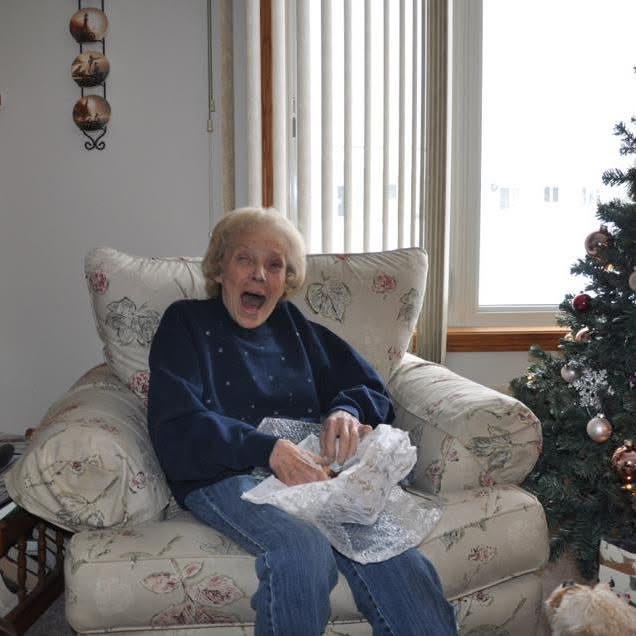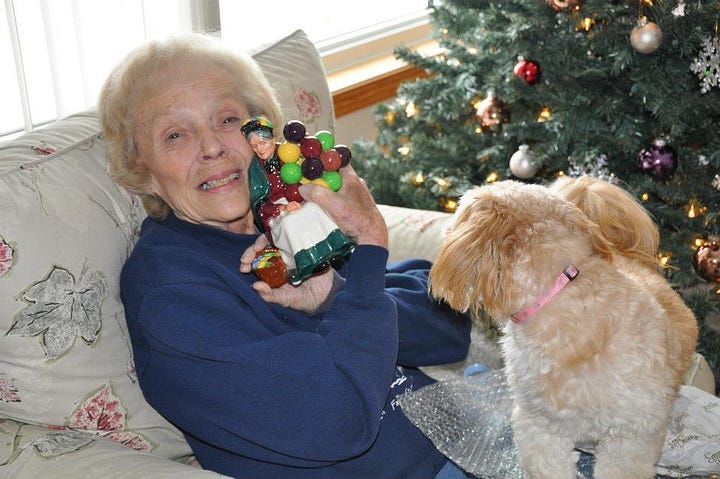My apologies up front to those of you hoping to find a recipe this week. There’s no culinary history in this piece. I’ve spent the last few weeks sorting through newly-inherited objects — photos, letters, old trophies and awards, books with scraps of life tucked between pages. Boxes and boxes of personal and family memorabilia, some rich with context and some barren of any attached memories whatsoever — at least for me.
All of it has brought me back to this idea. This family story. And this question: what role do keepsakes play in holding memories, and what happens when those keepsakes are lost?
Release date: January 23, 2025
What to do about the Old Balloon Seller
For years after her aunt, Myrtle, passed away, my mom, Renola, mourned the fact that she’d not inherited a specific decorative piece. Not only had she not inherited it, but the item – a Royal Doulton figurine titled Old Balloon Seller Woman – had simply disappeared following Myrtle’s death.
According to Mom, the colorful old woman had been a fixture in Myrtle’s home for as long as she could remember. She’d not been allowed to touch it as a child, of course, but she sure had admired it from afar, and dreamt of calling it her own one day.
I had my own memories of the Balloon Seller, and recalled it sitting on Auntie Myrtle’s fireplace hearth when I’d go visit her and Uncle Maurice at their Park Rapids, MN home as a little girl. But that was about the extent of my attachment – a backdrop to cherished memories.
Not so for Mom. For her, the loss of that old figurine was an open wound that refused to heal.
A few years before she passed away, I quizzed Mom again about Myrtle’s lost Balloon Seller, then went online to see if I could track one down. I eventually found two figurines in the UK that seemed to match Mom’s description and my own somewhat suspect memory – one woman standing and one woman sitting and both holding colorful balloons.

Although I winced at the cost, I covered my bases and ordered them both.
They arrived a few weeks before Christmas, and, unsure which one was thee one, I packed both in my suitcase as I headed back to Minnesota for the holidays. Later I casually started reminiscing about Auntie Myrtle, and then asked Mom to refresh my memory of her Balloon Seller. I remembered the green shawl, I said, but was she sitting, or standing?
Mom lit up, saying the old ballon seller was definitely sitting, and went on to describe her white skirt, the small basket at her side and even the details of the woman’s flowered hat.
Certain I had the proper replacement for Myrtle’s missing figurine, I quickly wrapped the sitting Balloon Seller, and returned the standing one to its hiding place in my suitcase.
When Christmas Eve arrived, I was the most excited person in the house!
I’ll never forget Mom’s reaction when she opened the box and saw the figurine, and I’m so glad I had my camera ready to capture the moment. Mom literally screamed with astonishment. And then came the tears, happy tears, her tears, my tears, tears filled with memories of the past and memories being made.
Tears of reunion.
It was and remains one of the most beautiful giving experiences of my life.


Mom cradled that new-to-her figurine like a firstborn for the rest of the evening, showing it off and pointing out its wonder to anyone who happened by. And by the time I woke up the next morning, Mom had cleared off a space of honor in her hutch, and placed her most cherished keepsake in its new home.
The Balloon Seller remained there until Mom passed away in 2013.
When the time came, my daughter asked if she might have the figurine. She’d grown up hearing about Auntie Myrtle and the original Balloon Seller from my mom, her grandma, and she’d been there when the replacement had been unwrapped and seen the joy on Mom’s face.
Of course I let her have it. It was, after all, a cherished family keepsake to her by then, too.
The Old Balloon Seller figurine has traveled the world with my daughter since then. And she’s been introduced to a fifth generation of family members who treasure her.
When asked, my young grandsons can recite our family’s history with the Balloon Seller; how she started out with Auntie Myrtle and then got lost for a while, before Nana found her again in England and gave her to Great-Grandma for Christmas, and then how Momma brought her home to live with them.
It matters not one wit that all those things happened well before any of them was born, or even that the Balloon Seller they know and love is a totally different figurine than the one that graced their 3x Great Auntie Myrtle’s hearth all those decades ago.
The stories belong to them now, and it is those stories — and the ones that will be created and shared in the years to come — that give value and meaning to the old Balloon Seller, not the other way around. And that’s as it should be.
As fellow writer and family historian here on Substack, Paul Chiddicks, so eloquently notes:
Of course we remember the special gifts that we receive, but I’m sure we remember the shared moments together more, the conversations and the laughter will be etched in our memories forever. Lasting joy doesn’t come from objects, it comes from experiences.
Copyright 2025 Lori Olson White
Your turn and your traditions
Think of an object in your life that holds significant personal or family memories. What memories does it evoke, and why is it meaningful to you? How does it help you stay connected to the people or events it represents?
Recall a time a meaningful object was lost or destroyed. What emotions did you feel at the time, and how did you cope? How have you worked to preserve the memories associated with it in other ways?
Reflect on an object you inherited from a loved one. What story does it tell about that person or your family’s history? How does having this object influence the way you remember them?
Imagine a keepsake you own being passed down to future generations. What do you hope it will mean to them, and how would you like its story to be preserved? How might its significance change over time?
Think about a memory that is tied to an object you no longer have. How do you keep that memory alive without the object? Do you feel the memory has changed or faded without the physical connection?
Consider a moment when you discovered an object tied to someone else’s past. How did the object deepen your understanding of their life or experiences? Did it inspire you to see your own keepsakes differently?
Think about an object in your family that is considered irreplaceable. What makes it irreplaceable, and how has it been cared for or protected? How might your family’s collective memory change if it were lost?
Reflect on the idea that some memories live on even without physical objects. What are some intangible ways you’ve kept memories alive? Do you think the loss of an object diminishes the memory, or can it make it stronger in unexpected ways?
On February 13, 2025, I will be presenting a family story close to my heart in a free program titled, Howard and Elvira: Love and the German Chocolate Cake, and I’d love to have you join me! This program will be held exclusively online and everyone is welcome. Link details will be emailed to you after registration. See you there!
Please hit the “like” button if you enjoyed this newsletter — it’s a little thing you can do to support my work!
Culinary History is Family History is reader-supported. When you buy through links on our site, we may earn an affiliate commission.





This is such an extraordinary post, Lori. I just love this story. Weirdly, I had a dream about such porcelain figurines just last night. I have none in my collection, nor any I inherited. They're a perfect example of something with imbued value like this. That look on your mother's face is precious.
Yes, I, too, have such an object that tears at my heart. I broke this extraordinary stoneware plate when it was mounted on my wall. My arm blindly knocked it while I was brushing my hair (or something.) One touch and it fell onto the stone floor. 🥺 I've saved the pieces. Treasured them, really. I suppose there's a little place in my world where retaining the pieces of broken stoneware will allow me to one day repair it with gold in the Japanese kintsugi manner. (tatsujin-style.com/blogs/journal/kintsugi-artists) It's not likely, but holding onto the pieces has allowed me to create new memories from the lessons it's taught me. I remember the day we traveled to the kiln where it was made in rural Japan. It was the masterpiece of several we purchased that day.
What an absolutely wonderful story! This is the first I’ve seen your Substack. I’m so glad I clicked into this. It made me smile, for sure.